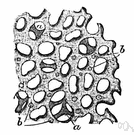lam·i·na
(lăm′ə-nə)n. pl. lam·i·nae (-nē′) or lam·i·nas
1. A thin plate, sheet, or layer.
2. Botany
a. The expanded area of a leaf or petal; a blade.
b. The bladelike part of a kelp.
3. A thin layer of bone, membrane, or other tissue.
4. Zoology A thin scalelike or platelike structure, as one of the thin layers of sensitive vascular tissue in the hoof of a horse.
5. Cytology A thin layer inside the nuclear membrane of a cell that is composed of a meshlike network of protein fibers.
6. Geology A narrow bed of rock.
[Latin lāmina.]
lam′i·nar, lam′i·nal adj.
American Heritage® Dictionary of the English Language, Fifth Edition. Copyright © 2016 by Houghton Mifflin Harcourt Publishing Company. Published by Houghton Mifflin Harcourt Publishing Company. All rights reserved.
lamina
(ˈlæmɪnə)n, pl -nae (-ˌniː) or -nas
1. a thin plate or layer, esp of bone or mineral
2. (Geological Science) a thin plate or layer, esp of bone or mineral
3. (Anatomy) a thin plate or layer, esp of bone or mineral
4. (Botany) botany the flat blade of a leaf, petal, or thallus
[C17: New Latin, from Latin: thin plate]
ˈlaminar, ˈlaminary, laminose, laminous adj
Collins English Dictionary – Complete and Unabridged, 12th Edition 2014 © HarperCollins Publishers 1991, 1994, 1998, 2000, 2003, 2006, 2007, 2009, 2011, 2014
lam•i•na
(ˈlæm ə nə)n., pl. -nae (-ˌni)
-nas.
1. a thin plate or layer.
2. a thin layer or coating lying over another, as in certain minerals.
3. the blade or expanded portion of a leaf.
[1650–60; < Latin lāmina]
Random House Kernerman Webster's College Dictionary, © 2010 K Dictionaries Ltd. Copyright 2005, 1997, 1991 by Random House, Inc. All rights reserved.
lam·i·na
(lăm′ə-nə)1. Botany The expanded area of a leaf or petal; a blade.
2. A thin layer of bone, membrane, or other tissue.
3. Geology A thin layer of sediment.
The American Heritage® Student Science Dictionary, Second Edition. Copyright © 2014 by Houghton Mifflin Harcourt Publishing Company. Published by Houghton Mifflin Harcourt Publishing Company. All rights reserved.
ThesaurusAntonymsRelated WordsSynonymsLegend:
| Noun | 1. |  lamina - a thin plate or layer (especially of bone or mineral) lamina - a thin plate or layer (especially of bone or mineral)lamina arcus vertebrae - lamina of the vertebral arch; the flattened posterior part of the vertebral arch from which the spinous process extends plate - any flat platelike body structure or part |
Based on WordNet 3.0, Farlex clipart collection. © 2003-2012 Princeton University, Farlex Inc.
lamina
nounThe American Heritage® Roget's Thesaurus. Copyright © 2013, 2014 by Houghton Mifflin Harcourt Publishing Company. Published by Houghton Mifflin Harcourt Publishing Company. All rights reserved.
Translations
lemezlevéllemez
lamina
lam·i·na
n. L. lámina, placa o capa fina;
___ arcus vertebrae → ___ del arco vertebral;
___ basalis choroidae → ___ basal de la coroide;
___ limitans anterior corneae → ___ elástica anterior de la córnea;
___ limitans posterior corneae → ___ elástica posterior de la córnea;
___ multiform of cerebral cortex → ___ multiforme de la corteza cerebral.
English-Spanish Medical Dictionary © Farlex 2012